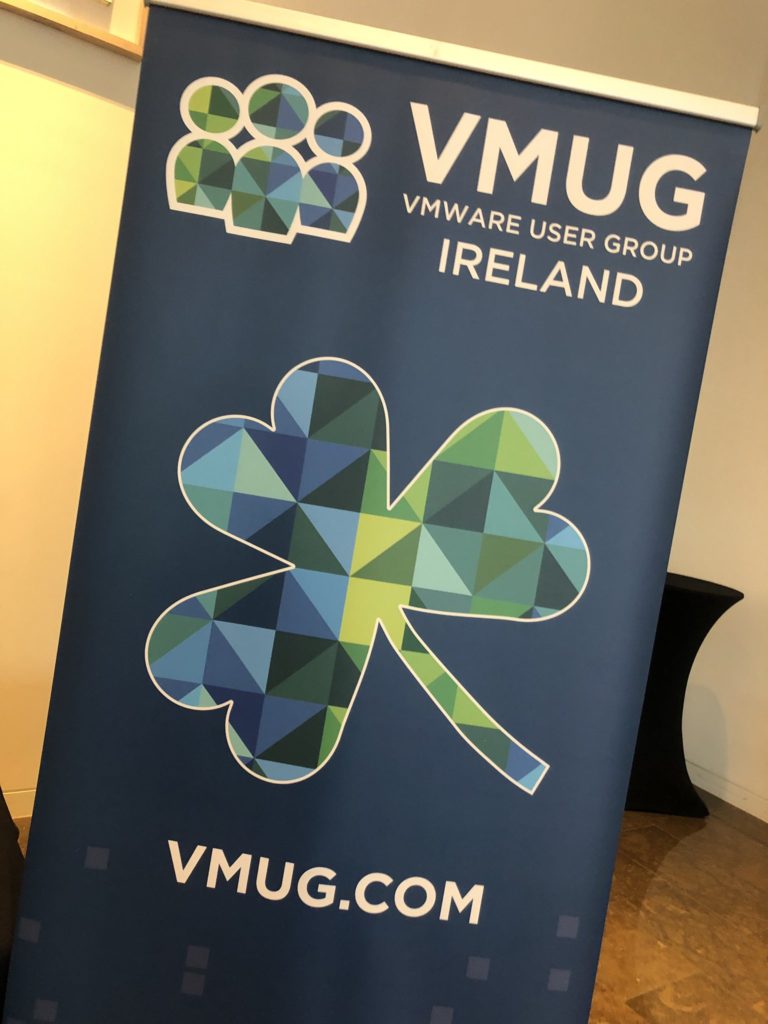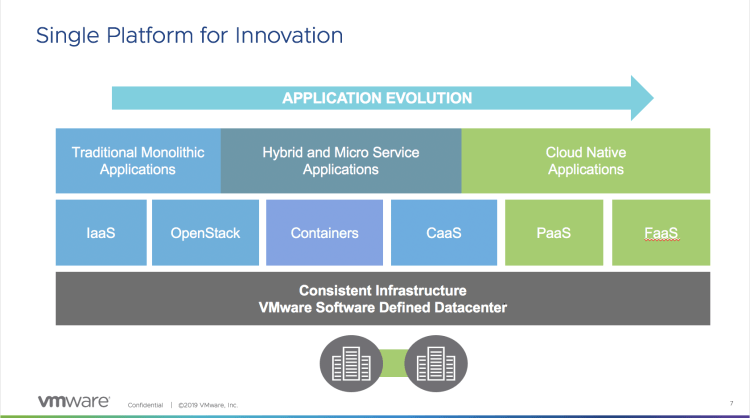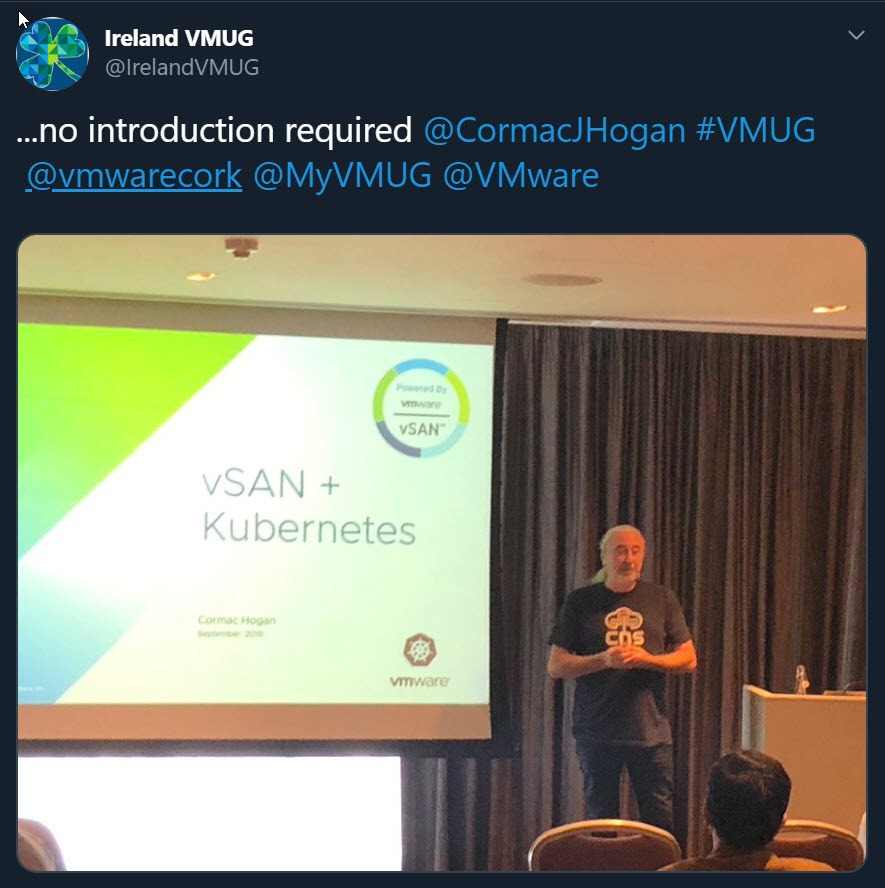Ireland VMware User Group: Kubernetes, k8s, Kubernetes!
I will give you three guesses what the September Ireland VMware User Group meeting in Dublin was all about. The VMUG event was packed with updates on Kubernetes, vSphere, and VMworld. It was standing room only from the start. The VMUG organizers moved everyone to a bigger room after the first session! Cormac Hogan began his own session by reminding everyone that VMUG is all about the community, all about the users. He would rather see end-users on the VMUG stage presenting how they used VMware solutions to solve problems, rather than only vendors sales pitches. All of the VMware presenters sessions were excellent, but i have to agree, the best session of the day came from the vCommunity.
VMUG is about vCommunity
The VMUG community session was presented by two community members from AIB. It was the last session of the day and the room was still full. The presenter from AIB asked the room, “How many of you look after infrastructure?”. I think almost every hand in the room shot up. This was in contrast to an earlier VMware presenter that had asked, “How many people are using Kubernetes?”. Very few hands went up that time. The presenter acknowledged Kubernetes was like teenage sex, it seems like a lot of people are talking about it but few are implementing it. Yet!

The presenter from AIB went on to describe how they had considered many different vendors and solutions on their digital transformation journey. AIB needed a new modern infrastructure strategy that worked for both Developers and Operators. They would need to maintain legacy applications they had and be able to pivot to new app development methods. They had decided that HCI was the answer for their infrastructure and they choose VxRack powered by VxRail. The best part of the session covered how they sold this new vision back to the business and were able to convince the board to make the new investment needed. It was very interesting to see how a business oriented session drew as much engagement as technology deep-dive one.
@edhoppitt says #RunAllTheThings
Ed Hoppitt from VMware kicked off the opening keynote. Ed works on the Modern Apss & Cloud Native Platforms team. He began by talking about innovation and how companies need different skillsets to innovate. He detailed the Pioneers, Settlers and Town Planners concept very well. I had read about this originally from the great Simon Wardley.

Ed had an excellent one-slide that illustrated how VMware is enabling customers Digital Transformation journey from traditional to cloud native applications. The slide described how vSphere and Consistent Infrastructure could cover everything from traditional to micro-services and cloud native. Ed talked about how a UK Finance company was using multi-cloud to satisfy governance rules. They needed to leverage multiple clouds and be able to shift from one cloud to another in less than 30 days. This is the true multi-cloud nirvana and a really great use case.
VMworld 2019 Recap by @rsudding

Ryan Sudding from Vmware was up next. He is a regular Ireland VMware User Group advocate and supporter. Ryan had the mammoth task of breaking down everything that was announced at VMworld in San Francisco. Ryan talked about VMware’s strategy to transform how customers Build, Run and Manage software on Kubernetes. He talked about the new acquisitions that complement this strategy including Bitnami, Pivotal and Heptio and the announcements around Project Pacific and Tanzu.
At VMUG if you aren’t networking your doing it wrong.

At the break I got the chance to sit down with Cormac Hogan for lunch. We were joined by Jason Pearse and Dean Lewis from VMware. We are all in the Dell Technologies family now so its great to chat about what is going on in VMware and Dell EMC. Dean is active on twitter and has an excellent blog running here. The conversation at lunch was really all about Project Pacific, Kubernetes, and VCF on VxRail. The future is bright! I also met up with Rob from Asystec as well as a friend I had not met up with my Y2K IT days. Small world, small vCommunity.
@CormacJHogan vSAN and Kubernetes

Cormac Hogan continued the trend of the day by talking about Kubernetes in his session. Cormac is a well known speaker and expert on vSAN. He started by covering the What’s New in VSAN 6.7u3. This included new features for Enhanced Performance, Intelligent Operations and Unified Management. The second part of the session was a high-level explanation of using vSAN as persistent storage for Kubernetes. He pointed out that everything in his session can be accessed on Storage Hub which is a great resource.
Cormac continued to give an update on vSphere Cloud Native Storage (CNS). He was sporting a CNS t-shirt therefore he must know his stuff. The content of this session is covered here in a blog. He finished up with a demo of CNS and briefly covered vSAN Native File Services. Cormac asked the audience what protocols they would like to see made available for vNFS next. The audience answers fell roughly inline with expectaions; NFS v3 then SMB followed by S3.
@opowero Kubernetes: Smooth Operators

Olive Power worked formerly at Heptio and now works at VMware. She presented the last session which was titled Smooth Operators: A rough guide to Kubernetes Operators. Olive blogs a bit about Kubernetes and Operators here. Olives session covered why we use Kubernetes; to reduce complexity, shorten release and test cycles. This is done by breaking up monolithic application architectures into micro-services and requires different/better tooling. The role of Kubernetes is to maintain the desired state. That way it can be self-healing for Containers and Applications running on K8s. Olive explained how Kubernetes is extensible and the role that Operators have on making it easier to deploy applications. She referenced a couple places to learn more about this topic: Awesome Operators and OperatorHub.io.


